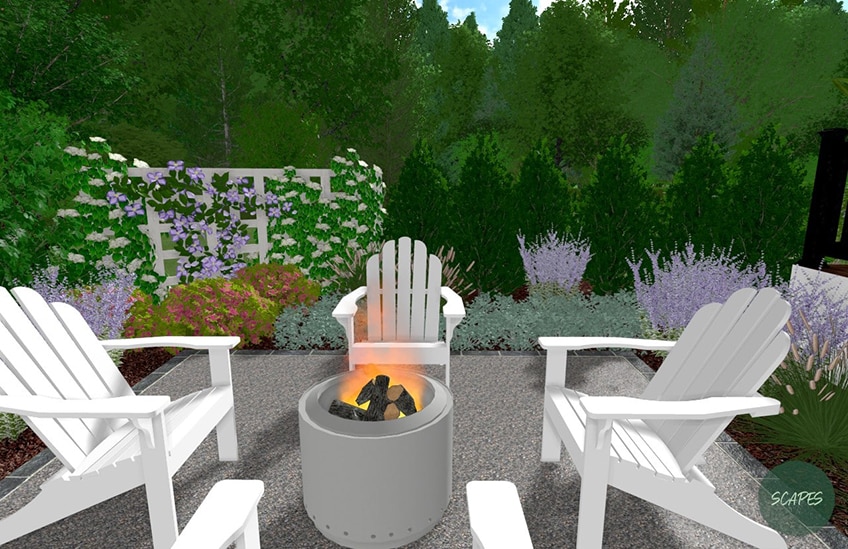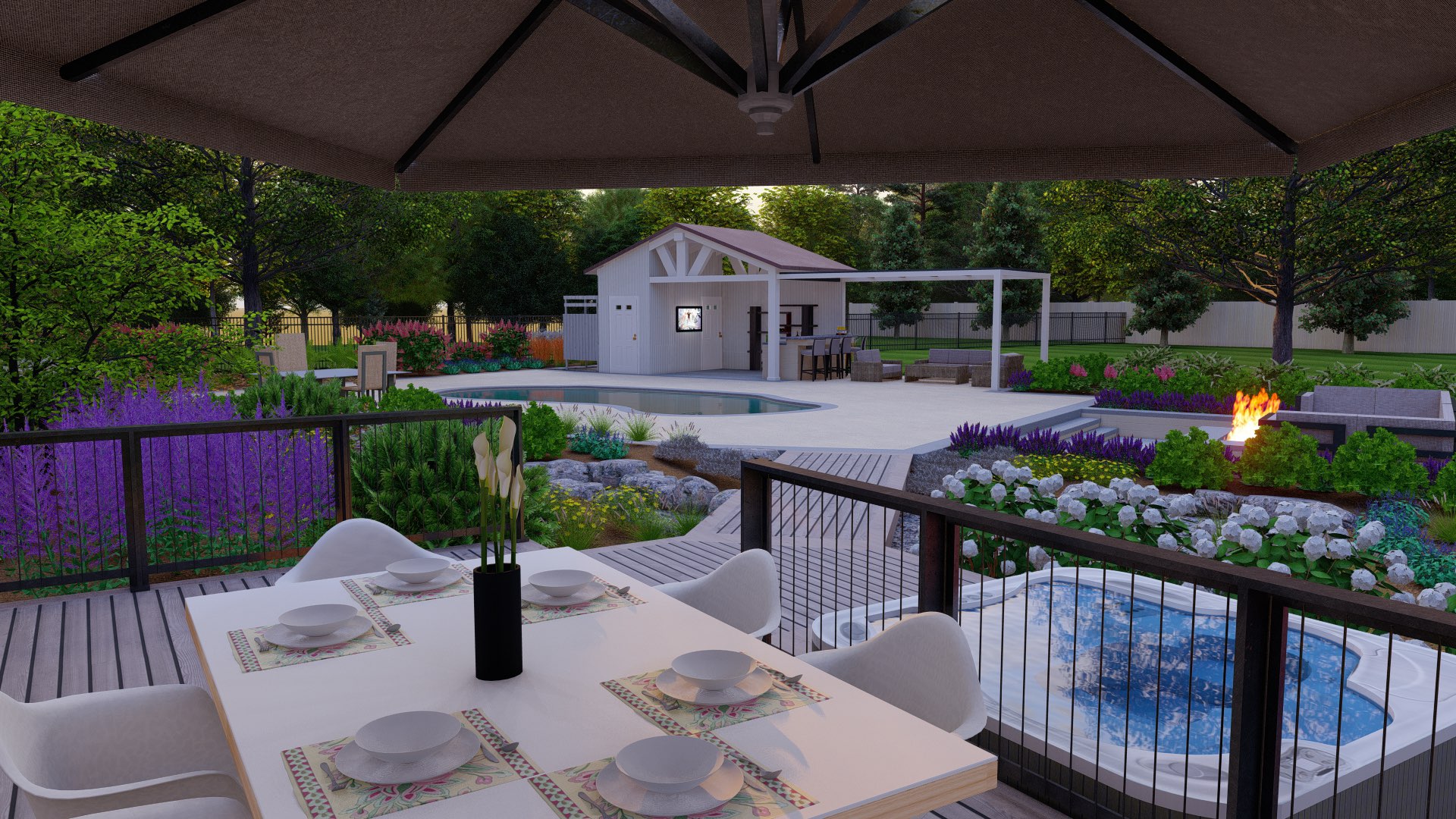Now that you have an understanding of what a landscape designer does and how they can add value to your outdoor living project, the search begins to find the best landscape designer. This raises a new set of questions like:
- Where do I start to find landscape designers that can help with my project?
- How do I find the BEST landscape designer?
- What questions should I ask my designer?
- What does the design process look like?
Below, we will take a deeper dive into each of these questions and provide answers to help you not only get the yard of your dreams, but ENJOY THE ENTIRE PROCESS!
Where can I find landscape designers that can help me?
Finding a landscape professional to help you craft your vision for your project can be a bit of a daunting task. After all, according to BLS statistics there are 43,951 landscape design businesses in the U.S. and approximately 16,000 licensed landscape architects. In other words, the options on where to find a designer are plentiful. In the age of the internet, Google can be a great place to start your search. This should help narrow down the list of designers to either local landscapers that provide design services, or internet-based companies that offer landscape designs in your geographic region of the country.
How do I find the BEST landscaping designer?
At this stage you will still have a long list. So, below we have outlined some expectations you should have of your designer to find the absolute BEST landscape design experience:
1. What is their primary business operation?
There are many different types of business entities in the landscaping industry that offer landscape design services. To illustrate the difference more clearly between these business types, we can classify them into two unique categories: Design-Specialists and Non-Specialists.
Design Specialists:
- Internet Landscape Design Providers
- Local Landscape Design Firms
- Landscape Architect Firms
Non-Specialists:
- Landscape Maintenance Contractors
- Landscape Design/Build Contractors
- Plant Nurseries
 Large scale outdoor living projects deserve high quality design renderings. Hand-drawn designs may be suitable for small projects, but the quality in the image above likely isn’t adequate for the scope of the project.
Large scale outdoor living projects deserve high quality design renderings. Hand-drawn designs may be suitable for small projects, but the quality in the image above likely isn’t adequate for the scope of the project.Knowing the primary business function can assist in finding the designer that will best provide a rendering that truly represents your wants and needs. The design product generated by a non-specialist can (and often will be) biased. A design prepared by these companies often represents a plan that meets their own wants and needs aimed at driving revenue for their primary business functions. A nursery may include plants that they have in stock rather than plants that are best suited to the site or your vision. A landscaper may design a space only with materials that they are comfortable working with or a style that produces the highest profit margin. The intent of a design-specialist entity is solely centered around the design and making sure that it accurately represents your vision – the biases of the non-specialist businesses are avoided in this manner.
2. Are they a local landscape designer or internet-based provider?
There are many home improvement scenarios that require an individual to physically visit a location to perform their landscaping services such as lawn mowing or tree services. Landscape design is not one of these scenarios. Local landscape designers have certain drawbacks when compared to companies that provide virtual landscape design services.
- The cost of hiring a local designer is often at least double what an internet landscape designer will charge.
- They are often solo designers, or small teams that do not have the capacity to turn around designs in a reasonable time frame
- They frequently lack set processes and procedures to ensure each customer receives a truly personal design experience
There are many tools available to remote landscape designers to allow us the opportunity to gather all pertinent site information without ever having to visit the site. Virtual meetings replace in-person site visits to review the objective of the design and presentations are prepared and presented via cloud-based platforms to allow immediate and infinite access to deliverable documents.
3. What kind of design services do they offer?
Landscape design has evolved rapidly over the last decade and the end product that will be delivered to you has changed with it. 3D landscape design is the most popular design option, but there are others that may suit your needs:
Photo-Realistic
“Your picture viewed through a designer’s lens.” This is the lowest cost landscape design service available with pricing as low as $139. A photo-realistic landscape design will begin with an image of an existing portion of the home that a landscape designer than digitally alters to include the desired landscape features. They are a great tool when there are no existing features to obstruct the clarity of the area to be designed and are a good fit for smaller landscape projects like a front yard landscape renovation.
Birds-Eye-View
Think “classic, blueprint-style designs reimagined” when you hear or see a Birds-Eye-View design being referenced. They are 2D plans that show an overhead view of your landscape design. They allow the opportunity to provide more detailed information than a Photo-Realistic render, and can handle any size landscape project. They are often paired with a Lifelike Rendering (more on these in a minute) as a construction drawing (commonly referred to as a Plan View drawing in the landscape industry).
Lifelike Renderings
There are many software programs that exist with the capability to provide 3D renders that are “accessible visualizations with depth and dimension”. This is by far the most popular design style in the landscape industry currently, and for good reason. 3D landscape designs are the best tool to provide accurate, lifelike visual representations of an outdoor living space. Back yard patio design ideas come to life with extreme visual clarity. Front yard landscape renovations are clearly shown at maturity to ensure the landscape ages exactly as intended. This is the best tool at a reasonable price point to know exactly what you are investing in your frontyard or backyard landscape project before committing to the full expense of the installation.
Virtual Reality
For the ultimate in a landscape design experience, consider SCAPES Reserve Collection – an industry-exclusive virtual reality design package. 3D landscape designs are taken to another level by utilizing virtual reality technology. You can now view your newly designed outdoor living space, before it is ever built, and from the comfort of your couch. The design team goes to work crafting your ideal landscape vision, and then we send you the necessary equipment to view the 3D landscape design at your own home. This type of immersive experience is invaluable for large-scale projects where a significant amount of monetary investment is being considered. Great landscape design service providers will offer a combination of these – the absolute best will offer all of them.
Flexible, Affordable Landscape Designs

What questions should I ask my designer?
In addition to the factors previously mentioned to consider when sourcing the best landscape designer for your project, there are some additional questions you may want to ask as part of your process:
1. What is their background in landscape design?
Knowing what kind of background your landscape designer has can be a critical component of the quality of landscape renderings provided. Additional questions like how long have they been designing landscapes, do they have a formal education in landscape design, and what aspects of the landscape industry have they worked in can all provide you with valuable information on the level of expertise the designer may possess.
2. What landscape design software do they use?
Hand-drawn landscape plans are still being performed by some designers, but most have adapted technology into their process. When it comes to landscape design software, there are many options available, and some are better than others. Some programs, like AutoCAD and Sketchup, are incredibly powerful tools but aren’t designed specifically for the landscape design industry. The ultimate drawback to this is their lack of efficiency, which translates into a higher cost. Landscape-specific design programs are preferred and result in a design with increased visual representation accuracy and reduced cost. Some examples of popular landscape design software include Realtime Landscaping Architect, VizTerra, and Pro Landscape.
3. What is their average turnaround time to deliver a design?
Designing a new landscape or outdoor living space is an exciting process and the delay over having a landscape design executed can put a damper on the enjoyment of the process. An acceptable design turnaround time should be in the 2-week range. Your designer should be able to get a smaller project (i.e. a small patio or front landscape renovation) executed in this amount of time, or less. Larger projects, like a backyard outdoor living space with a pool, pavilion, and outdoor kitchen may require slightly more time than 2-weeks. Some landscape design firms and landscape architect organizations tend to overcomplicate the process and push the process out to many weeks or even months. This adds an unnecessary delay to the process and ultimately inflates the cost.
4. How are revisions to the design handled?
As much as any landscape designer would love to nail the concept on the first render, it rarely happens this way. Landscape designs often contain many subjective elements and this can make it difficult to achieve a plan that perfectly captures your vision on the first design presented. The best landscape designers understand this and incorporate a clear process for revisions into their service. Requesting revisions can sometimes be uncomfortable or cause frustration that the design wasn’t acceptable on the first presentation – your designer should make you feel comfortable with this and proactively communicate that revisions are not only reasonable, but expected. And the absolute top-tier design services should include these at no additional cost to you!
5. What is included in the landscape design deliverables?
As mentioned, landscaping designs can be filled with complex items of subjectivity and unique elements. Because of this, it is important to have a clear understanding of what exactly will be included in the design you are purchasing. Some common elements that are often featured by the best landscape professionals for a 3D landscape design package include:
- 10-20 images of 3D rendered designs to present a clear visual representation of the concept
- 10-20 images of nighttime rendered design elements to showcase any outdoor lighting
- A detailed 2D plan view document that is drawn to-scale so that it can serve as the blueprint to install the landscape project
- Construction detail drawings of the hardscape, landscape, low-voltage lighting, structures, and any additional elements of the design that need to be installed
- A materials quantity takeoff that lists all hardscape, landscape, low-voltage lighting, structures, and any additional materials featured in the design
- Support documents from the manufacturers of the products and/or plants included in the design
Some of these items may incur additional charges, but your designer should have the capability to provide all of them as options.
6. After you have a design you love, what kind of support is provided as a next-step?
The landscape design for your project often generates a new set of questions regarding the installation, and your landscape designer should be able to help you navigate these questions and formulate a plan to move the project forward into the construction phase. The best landscape designers will have potential installation solutions through their network of vetted landscape installation professionals. Some may put you in touch with them, others may be able to offer an installation directly through their organization. Regardless of how the installation is handled, your landscape designer should be available for continued support through the completion of the project.
What should the landscape design process look like?
Taking an idea that is in someone’s head and generating a full landscape design can be a challenging task, but there is a method to the madness. The best landscape design service providers will not only have a clearly defined design process to help set and manage expectations, but they will have plenty of personal touchpoints built in. Some important aspects of the landscape design process to consider include:
 Landscape-specific design programs, like Realtime Landscaping Architect (shown here), are great tools to visualize a landscape while helping to keep costs in check.
Landscape-specific design programs, like Realtime Landscaping Architect (shown here), are great tools to visualize a landscape while helping to keep costs in check.1. An outline of the process
This may seem redundant, but it is an important step in the process. Having a document that clearly outlines the process you are about to go through with milestones that are measurable and attainable is a sign that you have the right landscape designer.
2. Interaction with the designer
A trend that is occurring in the landscape design space is automated processes that limit exposure to the designer that will be executing the design. This should be a red-flag and often generates poor results. Some companies verge on bait-and-switch territory and present their process as having ample designer interaction, but then feature limited or no interaction with an actual human after you have purchased the design. The best landscape design firms will want you to interact with their designer and will emphasize this as part of their process.
3. Questionnaire
The more information a designer has to start with, the more likely the first plant that is presented to you will accurately capture your vision. A questionnaire is an integral part of any design process so that the designer can learn things like your landscape design style, elements you would like featured in the design, and planting do’s and don’ts. This is where you have the most input in communicating your vision to the designer, so make sure all of the appropriate questions are being asked in the questionnaire.
4. Site information
Often included with the questionnaire, gathering pertinent site information impacts the accuracy of the design deliverables. There is now sufficient technology available to designers that we can get most of the information we need remotely. This is another step in the process that will typically require some input from you, and a designer may ask for items like a plot plan or photos of your home and existing landscape.
5. Design presentation
Once a designer has all necessary site information and a completed questionnaire, the design can be prepared and presented to you. The documents are typically presented electronically, or a virtual meeting can be incorporated into the process to have another personal touchpoint. The designer should be able to walk you through all elements of the design, why they were chosen, and what their intended effect is.
6. Revisions
As previously mentioned, the designer should help set the tone that revisions are expected. If there are any elements of the initial design that were not suitable, adjustments should be made in a timely manner (a few days or less) and the design updated and presented again. It is not atypical to go through a couple rounds of revisions. The process should be formulated with this in mind and the landscape designer acts in an accommodating manner to make sure you receive exactly what you are looking for.
7. Continued support
The best landscape designers often develop an attachment to the design they have created and want to see the project come to life. This means that they seek to remain in touch, help guide next steps when able, and answer any questions that inevitably pop-up during the construction process. After all, it is a form of art and the design is their artwork – it means something to the best landscape designers! Of course, the easiest way to find the BEST landscape designer is to stay right where you are and explore the design options we have available at SCAPES.


